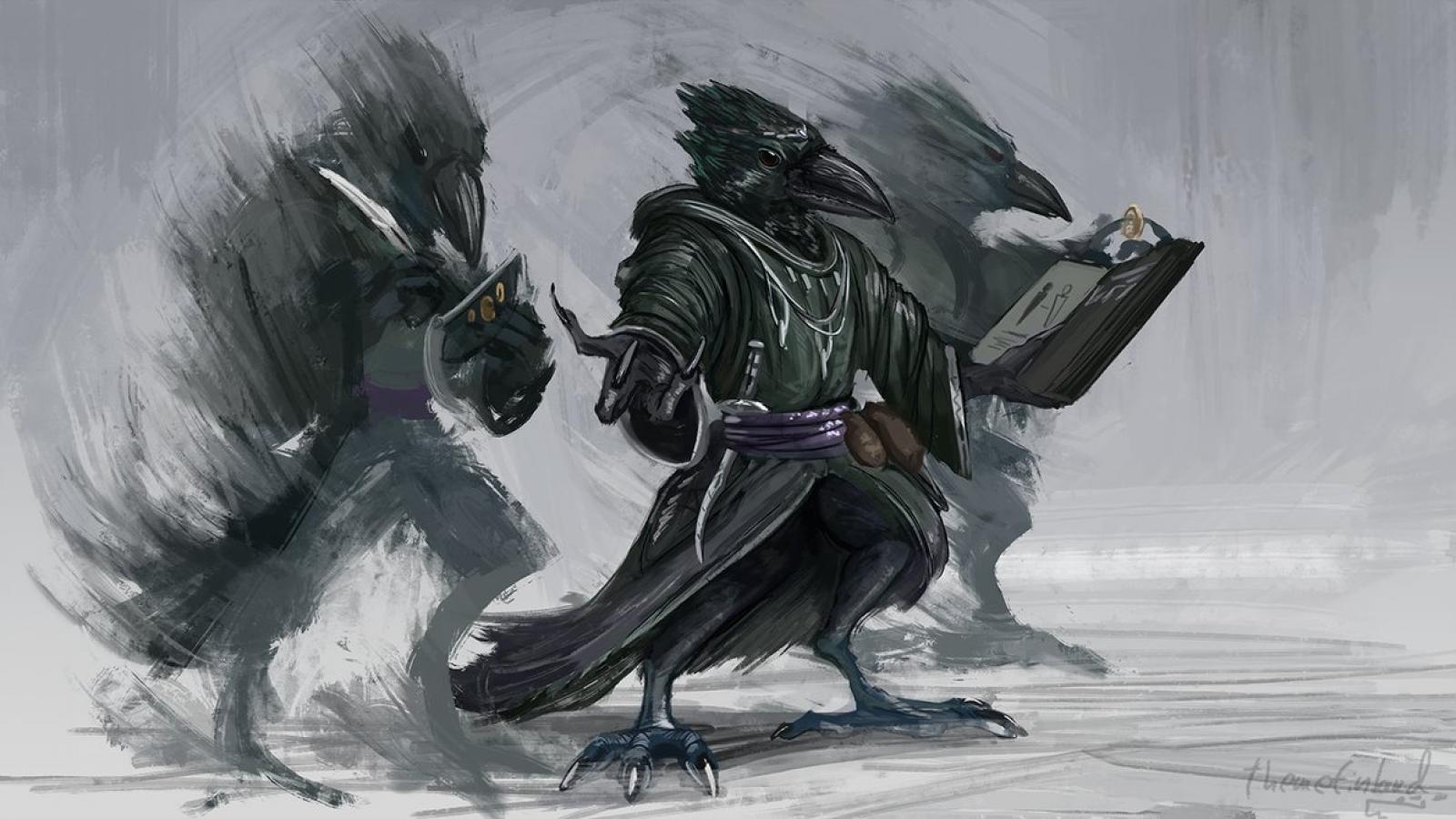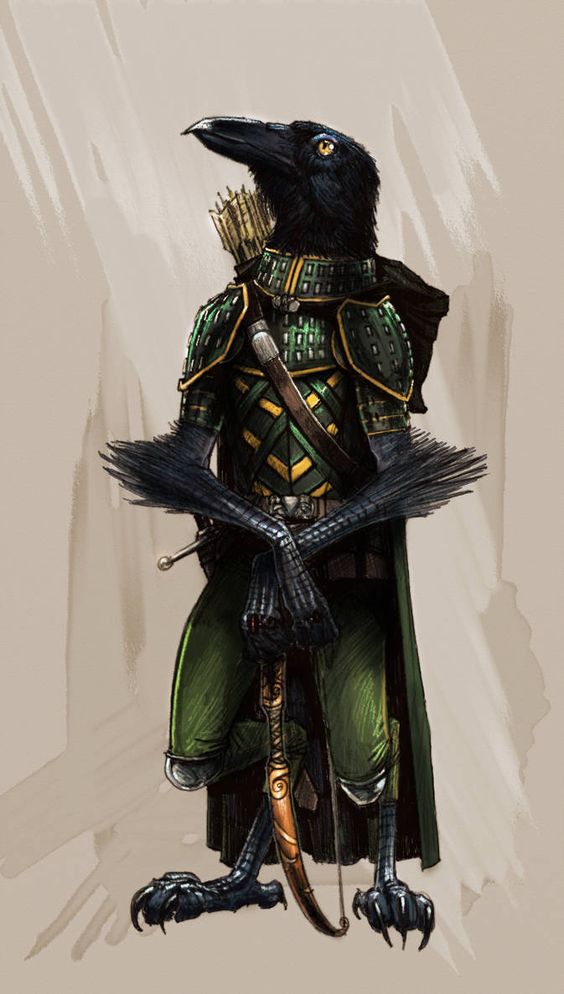Avian Heritage
Also known as kenku
Kenku are (c) Wizards of the Coast.
The kenku wander the world as vagabonds and burglars who live at the edge of human society. Kenku suffer from a sinister reputation that is not wholly unearned, but they can prove to be valuable allies. Kenku adventurers are usually the survivors of a flock that has sustained heavy losses, or a rare kenku who has grown weary of a life of crime. These kenku are more ambitious and daring than their fellows. Others strike out on their own in search of the secrets of flight, to master magic, or to uncover the secret of their curse and find a method to break it.
Basic Information
Kenku have raven-like faces with long black beaks instead of teeth and lips. Their bodies are covered with dark-colored, raven-like feathers. Kenku hands, feet, and legs below the knee are thin and covered in hard scales with a distinctive birdlike look tipped with sharp talons.
While kenku have cloaca in the manner of birds, their copulation occurs similar to most humanoids. A kenku lays ostritch egg-sized eggs about 30 days after being fertilized, generally between two and six of them per clutch. The eggs will then hatch into infant kenku chicks 4-5 months after being laid.
Despite starting quite a bit smaller than other humanoids, kenku mature rapidly during early life, their first five months equating to a human infant's first five years. After that they continue to mature at a slower rate until around age 12 at which point they are considered adults.
Kenku are an herbivorous species, preferring tree nuts, berries, seeds, and other small foodstuffs. Kenku are also fond of baked goods of all kinds, particularly fruity pies and breads.
Additional Information
Kenku sport a black beak generally between six and twelve inches long, and usually have wide yellow eyes.
Despite their lack of wings, kenku love dwelling in towers and other tall structures. They seek out ruins that reach to the sky, though they lack the motivation and creativity to make repairs or fortify such places. Even so, their light weight and size allow them to dwell in rickety structures that would collapse beneath a human or an orc.
Some thieves’ guilds use kenku as lookouts and messengers. The kenku dwell in the tallest buildings and towers the guild controls, allowing them to lurk in the highest levels and to keep watch on the city below.
Civilization and Culture
Given that kenku can duplicate any sound, their names are drawn from a staggering variety of noises and phrases. Kenku names tend to break down into three categories that make no distinction between male and female names.
Kenku thugs, warriors, and toughs adopt noises made by weapons, such as the clang of a mace against armor or the sound made by a breaking bone. Non-kenku refer to the kenku by describing this noise. Examples of this type of name include Smasher, Clanger, Slicer, and Basher.
Kenku thieves, con artists, and burglars adopt animal noises, typically those common in urban settings. In this manner, kenku can call out to each other while those who overhear them mistake them for common animals. Non-kenku use names that refer to the sound made or the animal a kenku mimics, such as Rat Scratch, Whistler, Mouser, and Growler.
Some kenku turn their back on crime to pursue legitimate trades. These kenku adopt noises made as part of their craft. A sailor duplicates the sound of a fluttering sail, while a smith mimics the clanging of a hammer on metal. Non-kenku describe these folk by their trade sounds, such as Sail Snap, Hammerer, and Cutter.
Kenku have almost no externally visible sexual dimorphism to distinguish a male and a female, therefore the ideal applies to both genders equally. Lustrous feathers are seen as a sign of health, as are a clean beak and clean talons.
Kenku courtship rituals closely follow their animal cousins. A kenku will want to provide a safe and comfortable 'nest' and present their chosen mate with shiny treasures in order to win their attention. Once your chosen mate's attention is captured a kenku woos them as any other humanoid might.
As a result of their lack of creativity, kenku function comfortably as minions of a powerful master. Flock leaders enforce discipline and minimize conflicts, but they fail at effective planning or crafting long-term schemes.
Although unable to speak in their own voices, kenku can perfectly mimic any sound they hear, from a halfling’s voice to the noise of rocks clattering down a hillside. However, kenku cannot create new sounds and can communicate only by using sounds they have heard. Most kenku use a combination of overheard phrases and sound effects to convey their ideas and thoughts.
By the same token, kenku have no ability to invent new ideas or create new things. Kenku can copy existing items with exceptional skill, allowing them to become excellent artisans and scribes. They can copy books, make replicas of objects, and otherwise thrive in situations where they can produce large numbers of identical items. Few kenku find this work satisfying, since their quest for the freedom of flight makes them ill-suited to settle into a routine.
Kenku gather in groups called flocks. A flock is led by the oldest and most experienced kenku with the widest store of knowledge to draw on, often called Master.
Although kenku can’t create new things, they have a talent for learning and memorizing details. Thus, ambitious kenku can excel as superb spies and scouts. A kenku who learns of clever schemes and plans devised by other creatures can put them to use. The kenku lack the talent to improvise or alter a plan, but a wise Master sets multiple plans in motion at once, confident that underlings can follow orders to the letter.
For this reason, many kenku make an easy living serving as messengers, spies, and lookouts for thieves’ guilds, bandits, and other criminal cartels. A network of kenku can relay a bird call or similar noise across the city, alerting their allies to the approach of a guard patrol or signaling a prime opportunity for a robbery.
Since kenku can precisely reproduce any sound, the messages they carry rarely suffer degradation or shifts in meaning. Human messengers might switch words or phrases and garble a message inadvertently, but the kenku produce perfect copies of whatever they hear.
Above all else, kenku wish to regain their ability to fly. Every kenku is born with a desire to take to the air, and those who learn spellcasting do so in hope of mastering spells that will allow them to fly. Rumors of magic items such as flying carpets, brooms capable of flight, and similar objects provoke a great desire for the kenku to acquire the items for themselves.
The original kenku that evolved out of the proto-gaian peoples had a pair of big black wings that sprouted from their backs with which they could fly. The largest sect of them was approached by worshippers of Zardesh, a malevolent modern god who saw them as potential spies. In the end the kenku agreed to become servants of this evil god, and were twisted by his wickedness. They proceeded to hunt down every other kenku that lived and either converted or killed all of them.
However, their newfound greed would be their downfall. The kenku plotted to steal their master's treasures, but their plans were found out, and a furious Zardesh bound every kenku by three terrible curses. First, the kenku’s beloved wings withered and fell away from their bodies, leaving them bound to the earth. Second, because their ingenuity and skill had turned toward scheming against their patron, the spark of creativity was torn from their souls. Finally, to ensure that the kenku could never divulge any secrets, their master took away their voices. Once he was satisfied that they had been sufficiently punished, Zardesh released the kenku from his service, abandoning them back into the world they forsook.
Since then, the kenku have wandered the world. They settle in places that accept them, usually bleak cities that have fallen on hard times and are overrun with crime.
Scientific Name
Homo farrago corvus
Lifespan
Kenku have shorter lifespans than most gaians, living only to about 60 years old.
Average Height
4 to 5 feet
Average Weight
90 to 120 lbs.
Average Physique
Kenku are generally lighter than their size would lead one to believe. Much of their bulk is made of feathers, while beneath that they are quite lean.
Body Tint, Colouring and Marking
Kenku are covered with layers of dark-colored feathers, typically black, which may include a cluster of longer tailfeathers and/or arm feathers. Kenku hands and feet are covered with hard scales.



Comments